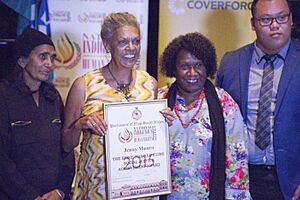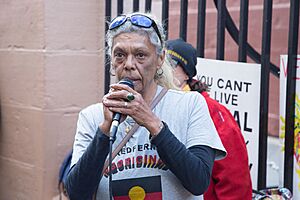Jenny Munro facts for kids
Jenny Munro is an important Wiradjuri elder and a strong leader for the rights of Indigenous Australians. She has worked hard to help Aboriginal people get housing at a place called The Block in Sydney. She also started the Redfern Aboriginal Tent Embassy. Jenny is the sister of other well-known activists, Isabel Coe and Paul Coe.
She is also an active member of the Waterloo Public Housing Action Group, which helps people living in public housing.
Jenny Munro's Early Life
Jenny Munro was born to Les and Agnes Coe. Her parents were also activists who fought for Aboriginal land rights. She is the younger sister of activist Isabel Coe and her brother Paul Coe. She also had another sister and brother.
Jenny grew up on the Erambie Mission, which is near the town of Cowra, New South Wales. In 1972, when she was young, her parents took her to the Aboriginal Tent Embassy in Canberra. There, they joined a protest by sleeping in tents to show their support for Aboriginal rights.
At 17, Jenny moved to Redfern, a suburb in Sydney. In 1972, she met her husband, Lyall Munro Jnr. They both became founding members of the Aboriginal Housing Company (AHC). This company helps provide homes for Aboriginal families. Jenny and Lyall moved into an AHC house in Marrickville, Sydney, where they raised their two children. Jenny also studied hard and earned a degree in arts and law from the University of New South Wales.
In 1978, Jenny Munro started working as a trainee bookkeeper at the Aboriginal Children's Services in Sydney. She later became the Administrator of the organization, helping to manage its work. She was also chosen to be the chairperson of the Secretariat of National Aboriginal and Islander Child Care (SNAICC). This group works to improve the lives of Aboriginal and Torres Strait Islander children. Jenny was involved in campaigns to encourage the New South Wales government to change how it dealt with Aboriginal issues. In the 1998 Australian federal election, she even ran as an independent candidate for the area called the electoral Division of Sydney.
The Redfern Aboriginal Tent Embassy

On May 26, 2014, Jenny Munro started the Redfern Aboriginal Tent Embassy. She did this to help get affordable housing back for the Aboriginal people who used to live in an area known as The Block. The Embassy continued to stay at The Block, even though there was a disagreement with the Aboriginal Housing Company, which had asked all the former Aboriginal residents to leave. In February 2015, Mick Mundine, the chairman of the Aboriginal Housing Company, said he would try to remove the protesters led by Jenny Munro. A major Sydney newspaper reported that the disagreement between the protesters and the Housing Company became more serious in 2015. The issue even went to the Supreme Court for a decision, and the State Attorney General was informed about the situation.
After more than 400 days of the Redfern Aboriginal Tent Embassy, Jenny Munro announced that they had won. This happened when the Federal Minister for Indigenous Affairs, Nigel Scullion, stepped in to help the Embassy. He helped create a peaceful solution between the Housing Company and the Embassy. Minister Scullion promised $5 million from the government to build 62 affordable homes for Aboriginal people on the site.
Awards and Recognition
- 2015 Eddie Mabo Award for Social Justice: Jenny Munro received this award at the National Indigenous Human Rights Awards. This award recognizes people who have made a big difference in fighting for fairness and rights in society.


